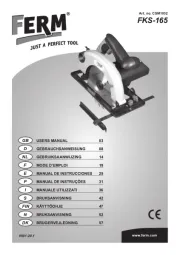FOM Blitz Manual
Læs gratis den danske manual til FOM Blitz (152 sider) i kategorien savemaskine. Denne vejledning er vurderet som hjælpsom af 35 personer og har en gennemsnitlig bedømmelse på 4.6 stjerner ud af 18 anmeldelser.
Har du et spørgsmål om FOM Blitz, eller vil du spørge andre brugere om produktet?

Produkt Specifikationer
| Mærke: | FOM |
| Kategori: | savemaskine |
| Model: | Blitz |
Har du brug for hjælp?
Hvis du har brug for hjælp til FOM Blitz stil et spørgsmål nedenfor, og andre brugere vil svare dig
savemaskine FOM Manualer

savemaskine Manualer
- Flex
- Evolution
- Power Craft
- Porter-Cable
- Pro-Cut
- Hurricane
- Exakt
- Dedra
- Shindaiwa
- FERM
- Spear & Jackson
- Clarke
- Jonsered
- Homelite
- DeWalt
Nyeste savemaskine Manualer









